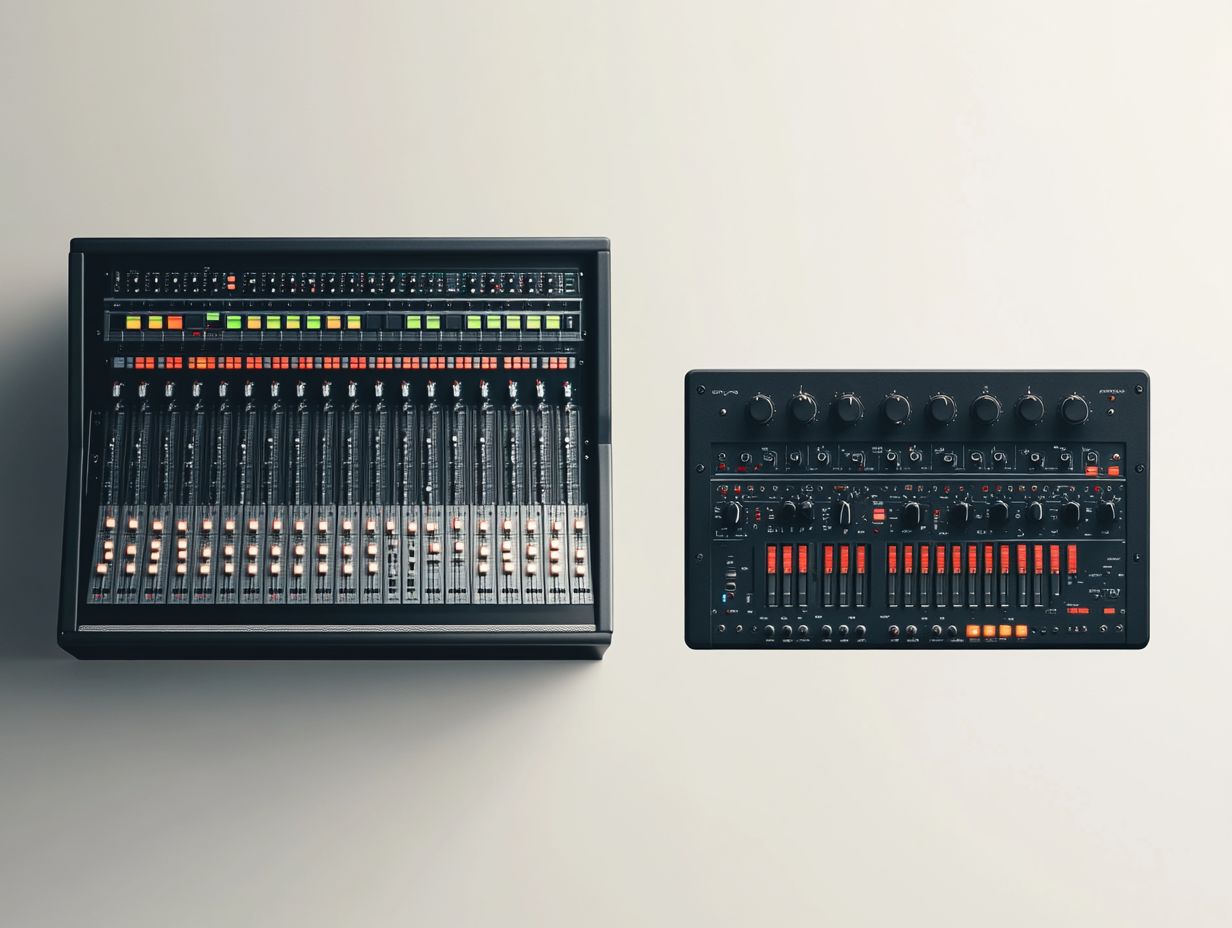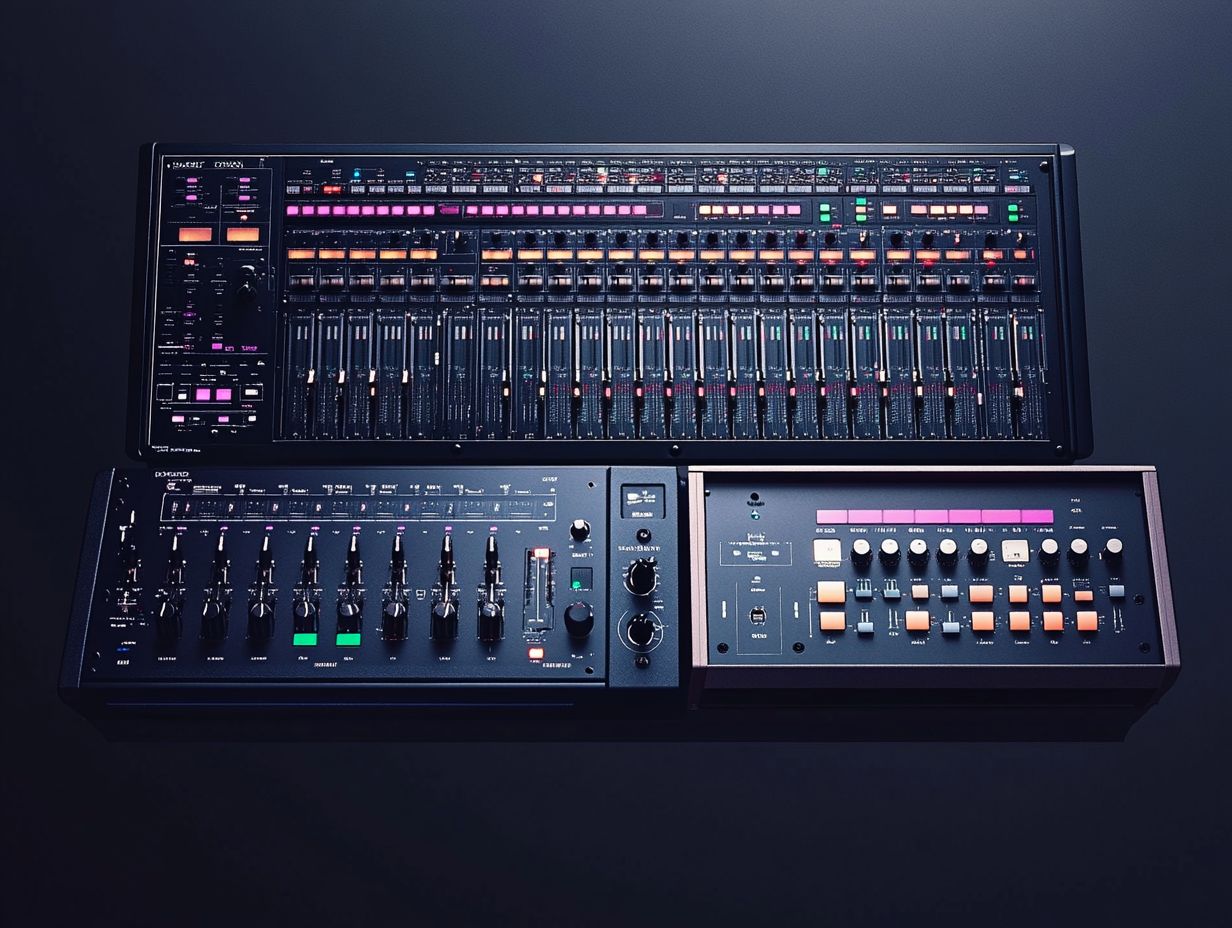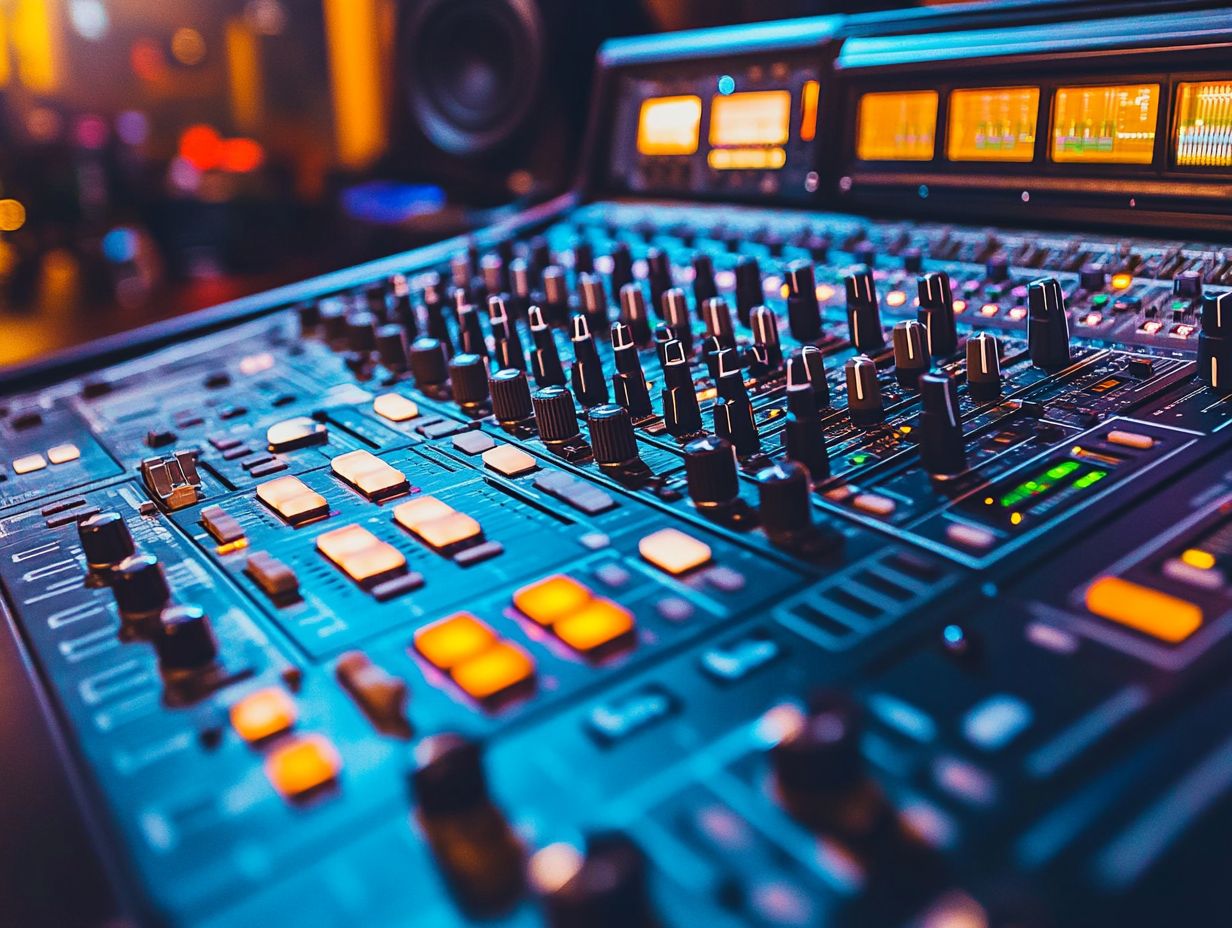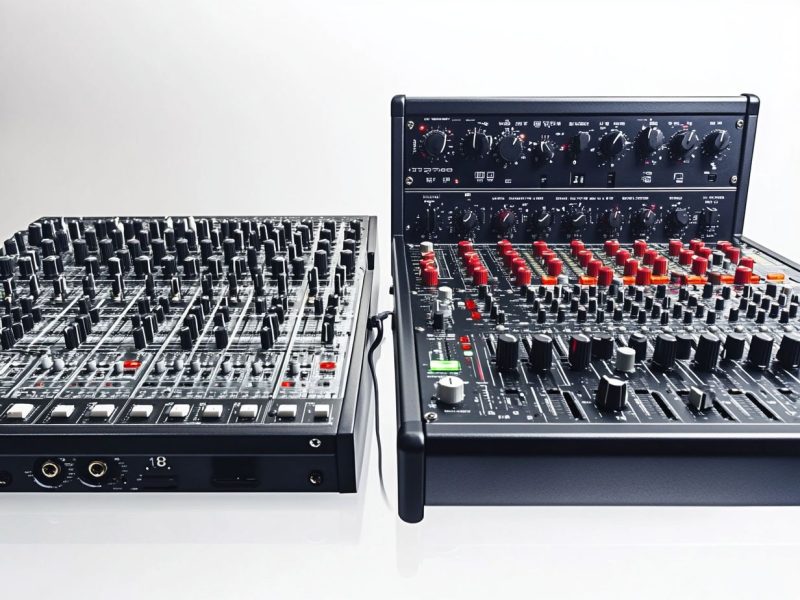In the realm of music production and sound engineering, a comprehensive understanding of the tools available is essential.
Mixing consoles and audio interfaces assume pivotal roles in the recording and mixing processes; however, they serve distinctly different purposes.
This guide will elucidate the function of each device, highlighting their unique features.
Furthermore, we will evaluate the advantages and disadvantages of both, assisting you in determining which option best aligns with your needs.
Whether you are an experienced professional or a novice, this guide will provide a thorough overview of the fundamentals associated with these vital audio instruments.
Understanding Mixing Consoles and Audio Interfaces

Mixing consoles and audio interfaces are essential elements in contemporary audio production, serving as vital components in the recording equipment arsenal utilized by musicians and sound engineers.
These devices enable sound mixing, convert audio signals, and substantially improve audio quality through their advanced functionalities.
In a properly organized studio environment or home studio, they facilitate efficient track mixing and monitoring while ensuring seamless integration with digital audio workstations (DAWs).
A comprehensive understanding of their features and functions is essential for individuals aiming to optimize their production workflow and achieve professional audio outcomes.
What are They and How do They Work?
Mixing consoles are sophisticated devices utilized by sound engineers to blend multiple audio sources, allowing for precise control over various parameters such as gain, equalization (EQ), and effects processing. In contrast, audio interfaces function as the essential link between analog and digital audio, converting electrical signals into digital data.
Each component within these systems plays a critical role in the overall signal flow. For example, preamps are responsible for amplifying low-level signals from microphones or instruments, thereby enhancing the clarity and presence of the sound prior to further processing.
Converters, in turn, take this amplified signal and transform it into a digital format that can be manipulated by computers. A comprehensive understanding of how these elements interact is vital for achieving optimal audio dynamics, as they collectively ensure high-quality sound that faithfully captures the nuances of the original performance.
The careful orchestration of these devices not only shapes the tonal characteristics of the audio but also establishes the foundation for the detailed editing and mixing processes that characterize professional recordings.
Features and Functions of Mixing Consoles
Mixing consoles are equipped with a range of features and functions that enable sound engineers to manipulate audio signals with precision, thereby ensuring optimal sound capture and processing for both studio recordings and live performances.
Key features include:
- Multiple input and output channels
- Faders for gain control
- Built-in effects for sound enhancement
- Comprehensive signal routing capabilities that facilitate complex audio setups
A thorough understanding of these features is essential for achieving professional mixing results, as they have a direct impact on audio fidelity and dynamics throughout the production process.
Signal Routing and Processing
Signal routing in mixing consoles is essential for directing audio signals through the appropriate pathways, thereby facilitating effective processing and manipulation of sound dynamics. Proper routing enables sound engineers to apply effects processing, manage audio feedback, and maintain optimal audio clarity and fidelity throughout the mixing process.
A comprehensive understanding of various routing techniques is crucial, as these techniques significantly influence the quality of the final output. For example, utilizing auxiliary sends can establish parallel processing paths for effects such as reverb and compression without negatively impacting the original signal.
Subgrouping channels allows engineers to manage multiple inputs efficiently, enabling the balancing of levels and the application of uniform processing. Additionally, the choice of routing affects the spatial characteristics of the mix, enabling creative panning and depth that enhance the overall listening experience.
In summary, mastering these routing strategies is vital for sound engineers to deliver a polished and professional sound that effectively captivates audiences.
Inputs and Outputs
The input and output configurations on mixing consoles are critical for establishing connections with a variety of audio sources, including microphones, instruments, and advanced monitoring systems. These configurations significantly influence audio fidelity and ensure optimal sound levels during both recording and mixing processes.
A commonly utilized connection is the XLR input, which is particularly suited for professional microphones due to its balanced design that minimizes noise interference. In contrast, TRS inputs are effective for handling line-level signals, offering flexibility in routing audio from synthesizers or drum machines.
In the contemporary digital landscape, USB connections have gained popularity, facilitating direct interfacing with computers for efficient recording and editing.
Each of these input types not only impacts the quality of the captured sound but also affects the monitoring of audio during sessions, rendering them essential components in both studio and live performance settings.
Features and Functions of Audio Interfaces

Audio interfaces function as a vital connection between musical instruments and computers, facilitating the conversion of analog signals from microphones and instruments into high-quality digital audio suitable for processing within a digital audio workstation (DAW).
Advanced features such as analog-to-digital conversion, USB audio connectivity, MIDI compatibility, and phantom power for microphones significantly enhance their utility in both home recording setups and professional audio environments.
Analog to Digital Conversion
Analog to digital conversion is an essential process that transforms the electrical signals generated by microphones and instruments into digital data that can be manipulated within a digital audio workstation (DAW), thereby significantly influencing the overall sound capture and audio quality.
This intricate transformation encompasses several key steps, primarily sampling and quantization.
During the sampling phase, the continuous analog signal is captured at specific intervals, with the sample rate playing a critical role in determining the frequencies that can be accurately reproduced. Higher sample rates facilitate a broader frequency response, thereby enhancing audio fidelity.
Subsequently, quantization assigns a numerical value to each sample, which impacts the dynamic range and overall detail of the sound.
When executed properly, these conversion processes yield rich and vibrant audio, capturing essential nuances that are crucial for professional mixing and mastering, ultimately ensuring that the final output meets the highest standards of quality.
Connectivity Options
Connectivity options on audio interfaces play a crucial role in enhancing the versatility of a recording setup, facilitating seamless integration with various devices and ensuring efficient signal transmission across input and output channels.
These interfaces typically include USB connections, which provide rapid data transfer speeds and simplify connections to laptops and desktop computers, thereby enhancing portability for musicians who travel frequently.
Additionally, MIDI ports enable communication between digital instruments and software, while traditional analog inputs and outputs accommodate a variety of microphones, instruments, and studio monitors.
The selection of connectivity options has a direct impact on the usability of the audio interface. Therefore, it is essential for users to consider how their specific production workflows may benefit from a diverse range of options. This consideration is particularly important in both home studios and professional environments, where operational efficiency is paramount.
Pros and Cons of Using a Mixing Console
Utilizing a mixing console presents several advantages and disadvantages that can substantially influence audio professionals and their production workflows.
On the positive side, mixing consoles offer a wide range of capabilities for professional mixing, delivering comprehensive control over audio dynamics, routing, and effects processing. Conversely, they may also pose challenges, including higher costs and increased complexity in setup and operation, particularly for individuals who are new to sound engineering.
Advantages and Disadvantages
The advantages of utilizing a mixing console encompass superior audio quality, comprehensive control over sound mixing, and the capability to effectively manage multiple input sources. This makes them a preferred choice among sound engineers.
On the other hand, the disadvantages may include higher costs and a steeper learning curve, particularly for individuals who are accustomed to simpler audio interfaces.
These consoles give the power to sound engineers to adjust levels, equalization, and effects in real-time, thereby ensuring that every nuance of a performance is accurately captured and enhanced for the audience. For instance, in a live concert setting, the ability to quickly modify audio settings can significantly influence the overall sound experience, highlighting the system’s reliability.
However, potential drawbacks may arise, particularly when transitioning to a more complex setup; engineers may feel overwhelmed by the multitude of knobs and features available. Additionally, in scenarios where portability is crucial, such as mobile recording sessions, the bulkiness of high-end mixing hardware can present challenges, leading to a preference for more compact digital alternatives, even if these may sacrifice a certain level of audio fidelity.
Pros and Cons of Using an Audio Interface

Audio interfaces present a variety of advantages and disadvantages that affect their application in both professional and home recording settings.
On the positive side, they offer cost-effective and portable solutions for high-quality audio capture, allowing musicians to produce music with minimal latency and exceptional sound fidelity.
Conversely, some users may encounter limitations in connectivity options and processing capabilities when compared to more comprehensive mixing consoles.
Advantages and Disadvantages
The advantages of utilizing an audio interface include affordability, portability, and the capability to deliver high-quality sound capture, making it an ideal option for home recording setups. However, disadvantages may include limited processing features and potential compatibility issues with specific software and equipment.
For example, while many entry-level audio interfaces can seamlessly connect to laptops and tablets, users requiring advanced sound manipulation may find their capabilities insufficient compared to more sophisticated digital audio workstations.
A significant benefit of audio interfaces is that they often include bundled software, which enhances the overall user experience by streamlining the recording process. Conversely, some models may feature limited inputs and outputs, which could restrict the number of devices that can be utilized simultaneously. This limitation may pose challenges for individuals working with larger setups or in collaborative environments.
Therefore, it is essential to understand one’s specific requirements when selecting the appropriate audio interface.
Which One is Right for You?
The decision between a mixing console and an audio interface is influenced by several factors, including the complexity of the production workflow, budget constraints, and specific audio requirements.
For example, professional audio engineers may opt for mixing consoles due to their comprehensive control capabilities and advanced features.
In contrast, musicians working within home studio environments might favor the simplicity and portability offered by audio interfaces.
Considerations and Recommendations
When selecting between a mixing console and an audio interface, it is essential to consider factors such as audio quality requirements, user-friendliness, and the specific recording setup intended for use.
For individuals prioritizing portability and straightforward functionality, an audio interface may be the more suitable option. Conversely, those requiring advanced features and configurations may prefer a mixing console.
In assessing audio quality, it is important to focus on the bit depth and sample rate, as these parameters directly influence the clarity and richness of recordings. Additionally, the recording environment plays a critical role; users operating in professionally treated studios may benefit from the enhanced capabilities of a mixing console, while those in less controlled settings might find that a compact and versatile audio interface better meets their needs.
Budget considerations are also a significant factor in the decision-making process. Entry-level audio interfaces can provide excellent sound quality at a reasonable cost, whereas professional mixing consoles, despite their higher price points, offer extensive routing options and advanced processing capabilities.
For musicians who travel frequently, lightweight devices with USB connectivity are invaluable, facilitating high-quality recordings wherever inspiration may arise.
Frequently Asked Questions
What is the difference between a mixing console and an audio interface?

A mixing console is a physical hardware device used to control and manipulate audio signals, while an audio interface is a digital device used to convert analog audio signals into digital signals for recording and playback.
Can a mixing console act as an audio interface?
Some mixing consoles do have built-in audio interfaces, but not all of them. It’s important to check the specifications of a mixing console to see if it has this capability.
What are the advantages of using a mixing console over an audio interface?
A mixing console allows for more hands-on control and manipulation of audio signals, and often has more inputs and outputs than an audio interface. It also offers features such as EQ, dynamics processing, and routing options.
When would it be more beneficial to use an audio interface instead of a mixing console?
An audio interface is typically more compact and portable, making it a better choice for on-the-go recording or home studio setups. It also allows for more precise digital control and editing of audio signals.
Do I need both a mixing console and an audio interface for my recording setup?
It depends on your specific needs and preferences. If you require hands-on control and processing of audio signals, a mixing console may be necessary. However, if you primarily work with digital audio and value portability, an audio interface may be sufficient.
Can I use a mixing console and an audio interface together?
Yes, it is possible to use both in conjunction with each other. The audio interface can serve as the digital converter and the mixing console can be used for processing and control of the audio signals. This can be a beneficial setup for larger recording projects or live performances.


 Unleash the Power of Wireless Guitar Systems for Electrifying Live Performances
Unleash the Power of Wireless Guitar Systems for Electrifying Live Performances